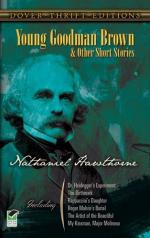|
This section contains 2,637 words (approx. 9 pages at 300 words per page) |

|
SOURCE: "The Bedeviling of Young Goodman Brown," in Modern Language Quarterly, Vol. XIX, No. 4, December, 1958, pp. 331-36.
In this essay, Walsh discusses the threefold symbolic pattern of Goodman Brown's experience in the forest which results in his surrender to despair.
Had Goodman Brown fallen asleep in the forest and only dreamed a wild dream of a witch-meeting?
The above question, found in the second to the last paragraph of Nathaniel Hawthorne's famous short story, "Young Goodman Brown," has perhaps inspired more comment than any other sentence of the author's works. But it is futile to attempt to answer the question, especially since the author himself has intentionally avoided it. Yet most commentators have chosen between the two alternatives that Hawthorne has offered, and their choice determines the meaning they give to the short story: those who think that Goodman Brown's experience in the forest is not a dream...
|
This section contains 2,637 words (approx. 9 pages at 300 words per page) |

|


